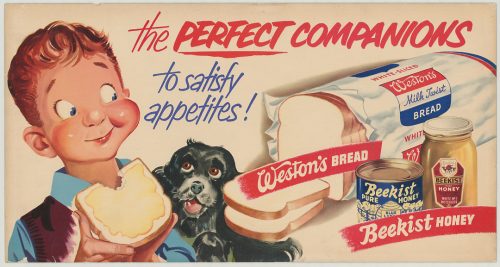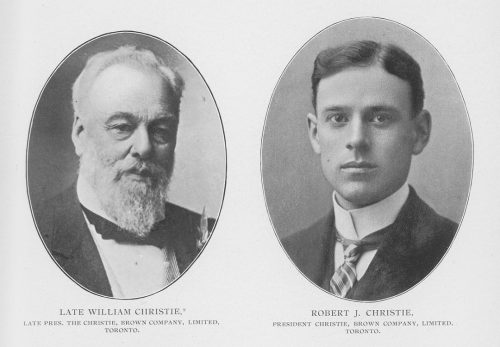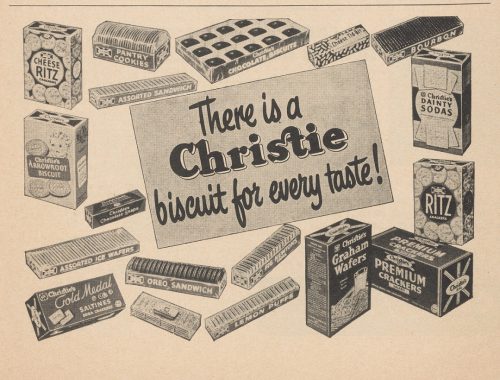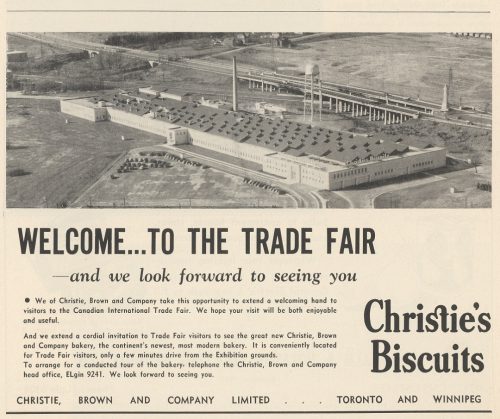
George Weston (1864-1924) started life in the bakery trade as a 12-year old apprentice. By 1882, he had acquired enough money and experience to purchase his own bread route from his employer Gilbert H. Bowen. Two years later, Weston bought out Bowen’s bakery on Sullivan Street, renaming it G. Weston’s Bread Factory. It was here that Weston developed his famous “Real Home-Made Bread” using a combination of Manitoba #1 hard wheat and Ontario fall wheat.
Weston’s success eventually required him to seek out new and larger premises. In 1897 he completed construction of his Model Bakery at the corner of Soho and Phoebe streets, producing up to 20,000 loaves per week of more than 30 different kinds of bread – more than any other bakery in Canada at the time.
In 1911, when Weston amalgamated his Model Bakery with a number of other firms from across Canada to form the Canada Bread Co. Ltd. he shifted his attention to the biscuit trade. A new biscuit factory was constructed at the north-west corner of Peter and Richmond streets where products such as Weston’s Golden Brown Sodas and Weston’s English Quality Biscuits were manufactured.

One of the more iconic brands in George Weston Ltd.’s portfolio was Wonder Bread, acquired in 1985. It made its first appearance in Toronto in 1930 and by 1934 was being produced by the Ideal Bread Co., which occupied a five-storey factory on the north-east corner of Argyle Street and Dovercourt Road.
An example of multi-level manufacturing, the fifth floor was where dry ingredients were weighed and combined; the fourth floor was used for mixing and proofing the dough; the third floor housed the machinery for forming and baking loaves of bread; the second floor was where products were packaged; and the ground floor was the site of the bakery’s shipping and receiving operations. An elevator carried the raw materials up to the top floor from storage bins in the basement.
Ideal Bread’s travelling ovens used conveyor belts to move large volumes of unbaked bread through a 70-foot long, gas-fired tunnel from which they emerged fully baked. This small step toward automated production lines enabled the company to increase its production volumes. In 1924, Ideal Bread declared that their five travelling ovens could produce 15,000 loaves per hour.
Merging with Montreal-based Wonder Bakeries Ltd. in 1938, the company retained the Argyle Street facility until 1957. Designed by Montreal-based architect Sydney Comber, an authority on the design of industrial bakeries, the steel-frame and concrete building featured included drinking fountains, showers, and lockers as well as a large 400-seat meeting room used to host concerts and other events for bakery staff. In 1978 the building was added to the City’s Inventory of Heritage Properties and was designated under the Ontario Heritage Act in 2002. It was converted to residential lofts in 2007.
After completing his baker’s apprenticeship, William Mellis Christie (1829-1900) emigrated from Scotland to Toronto, where he felt his prospects would be brighter. By 1860, he had established himself as an award-winning biscuit maker in a successful partnership with his father-in-law. At a time when production was still largely reliant on hand work, Christie’s six employees were manufacturing 4,300 boxes of biscuits a year in his bakery at 626 Yonge Street just south of Bloor.
Increasing demand for his product led Christie to expand the business. In 1868 he added steam-powered machinery, entered a new partnership with former employer Alexander Brown and, in 1874, built a new plant at the south-west corner of Duke (now Adelaide Street) and Frederick streets – currently part of the St. James campus of George Brown College. By the 1880s, Christie, Brown and Company was the largest biscuit manufacturer in Canada, producing more than 400 kinds of cakes and biscuits. By 1890, 20% of workers in the bakery industry in Toronto were reported to have worked at Christie’s.

In 1900, William Christie died and the business was taken over by his son Robert. Valued at $500,000, Christie, Brown and Company had grown to include offices in Toronto and Montreal and a staff of 375. In 1928, the family sold the company to the Chicago-based National Biscuit Company, better known as Nabisco.

Christie’s slogan was a familiar sales pitch in the biscuit trade. The phrase “a biscuit for every taste” appears in print advertisements for companies ranging from Quebec’s Epicerie Elzear Turcotte (1915) to Edmonton’s North-West Biscuit Co. (1922). The slogan was even featured in a 1915 case study in Canadian Grocer magazine on how to drive the sale of fancy biscuits through newspaper ads and in-store show cards.
In 1950 a new plant at Lake Shore Boulevard West and Park Lawn Road was opened. The modern new factory was distinguished by its water tower bearing the red and white Christie triangle trademark.

In 2013, the Christie plant closed its doors after 63 years in business, eliminating 550 jobs. The Christie brand survives in the portfolio of Modelez International, an American multinational food, confectionary and beverage company.